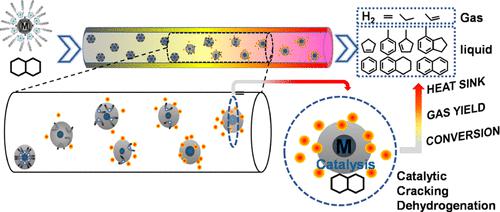当前位置:
X-MOL 学术
›
Energy Fuels
›
论文详情
Our official English website, www.x-mol.net, welcomes your feedback! (Note: you will need to create a separate account there.)
Heat Sink Enhancement of Decalin by Symmetrical Imidazolium Ionic Liquid-Capped Metal Nanoparticles
Energy & Fuels ( IF 5.2 ) Pub Date : 2023-04-18 , DOI: 10.1021/acs.energyfuels.3c00440 Ruiqing Zhang 1 , Ziwei Zhai 1 , Li Wang 1 , Sibao Liu 1 , Guozhu Liu 1, 2, 3
Energy & Fuels ( IF 5.2 ) Pub Date : 2023-04-18 , DOI: 10.1021/acs.energyfuels.3c00440 Ruiqing Zhang 1 , Ziwei Zhai 1 , Li Wang 1 , Sibao Liu 1 , Guozhu Liu 1, 2, 3
Affiliation

|
Catalytic cracking–dehydrogenation of hydrocarbon fuels with hydrocarbon-soluble metal nanoparticles is an appealing way to improve fuel heat sink in a high-speed aircraft. In this work, two hydrocarbon-soluble metal nanoparticles (Pd@ILs and Pt@ILs) by using symmetrical imidazolium ionic liquids (1,3-bis(14-alkyl) imidazolium bromide) as protective agents were successfully synthesized. The catalytic performance for cracking and dehydrogenation of decalin-based nanofluids was investigated using an electrically heated tubular reactor. In comparison with Pd@14N with the conventional tetradecylamine ligand, Pd@ILs and Pt@ILs catalysts exhibited smaller average particle sizes and showed better performance in terms of dispersion stability, thermal stability, and catalytic activity. Fourier transform infrared (FT-IR) and density functional theory (DFT) calculations demonstrated that the strong affinity of C atoms in the conjugate imidazole ring to the metal surface allows these nanoparticles to be stably dispersed in decalin for at least 2 months. In the quasi-homogeneous conversion of decalin, Pd@ILs exhibited the best performance in promoting fuel cracking and dehydrogenation conversion with the highest yields of hydrogen and unsaturated hydrocarbon products, especially aromatic products, thus enhancing the heat sink of nanofluids. Particularly, the heat sink of nanofluids with the Pd@ILs catalyst was 3.39 MJ kg–1 at 700 °C, which was 0.58 MJ kg–1 higher than that from decalin thermal cracking and 0.43 MJ kg–1 higher than that of the nanofluids with the Pd@14N catalyst. In addition, Pd@ILs nanofluids gave the highest heat sink of 3.61 MJ kg–1 at 725 °C. The significant enhancements are attributed to cooperative interplay between the initiation effect of ILs and the remarkable catalytic ability of Pd nanoparticles in cracking–dehydrogenation reaction, as well as the unique properties of Pd@ILs, including smaller Pd particle size, more accessible surface Pd active sites, and higher thermal stability. This work shows that symmetrical imidazolium ionic liquid-capped metal nanoparticles can serve as effective quasi-homogeneous catalysts for enhancing heat sink of hydrocarbon fuels through catalytic cracking and dehydrogenation.
中文翻译:

对称咪唑离子液体包覆金属纳米粒子增强萘烷的散热性能
使用碳氢化合物可溶性金属纳米颗粒对碳氢化合物燃料进行催化裂化脱氢是改善高速飞机燃料散热的一种有吸引力的方法。在这项工作中,以对称咪唑离子液体(1,3-双(14-烷基)咪唑溴化物)为保护剂,成功合成了两种烃溶性金属纳米粒子(Pd@ILs 和 Pt@ILs)。使用电加热管式反应器研究了萘烷基纳米流体的裂化和脱氢催化性能。与传统十四烷基胺配体的Pd@14N相比,Pd@ILs和Pt@ILs催化剂表现出更小的平均粒径,在分散稳定性、热稳定性和催化活性方面表现出更好的性能。傅立叶变换红外 (FT-IR) 和密度泛函理论 (DFT) 计算表明,共轭咪唑环中的 C 原子与金属表面的强亲和力使这些纳米粒子能够稳定地分散在萘烷中至少 2 个月。在十氢化萘的准均相转化中,Pd@ILs 在促进燃料裂解和脱氢转化方面表现最佳,氢和不饱和烃产物(尤其是芳烃产物)的产率最高,从而增强了纳米流体的热沉。特别地,具有 Pd@ILs 催化剂的纳米流体的热沉为 3.39 MJ kg 在十氢化萘的准均相转化中,Pd@ILs 在促进燃料裂解和脱氢转化方面表现最佳,氢和不饱和烃产物(尤其是芳烃产物)的产率最高,从而增强了纳米流体的热沉。特别地,具有 Pd@ILs 催化剂的纳米流体的热沉为 3.39 MJ kg 在十氢化萘的准均相转化中,Pd@ILs 在促进燃料裂解和脱氢转化方面表现最佳,氢和不饱和烃产物(尤其是芳烃产物)的产率最高,从而增强了纳米流体的热沉。特别地,具有 Pd@ILs 催化剂的纳米流体的热沉为 3.39 MJ kg–1在 700 °C 时,比萘烷热裂解高0.58 MJ kg –1,比使用 Pd@14N 催化剂的纳米流体高0.43 MJ kg –1 。此外,Pd@ILs 纳米流体的最高散热量为 3.61 MJ kg –1在 725 °C。显着增强归因于 ILs 的引发效应与 Pd 纳米粒子在裂解-脱氢反应中的显着催化能力之间的协同相互作用,以及 Pd@ILs 的独特性质,包括更小的 Pd 粒径、更易接近的表面 Pd 活性站点和更高的热稳定性。这项工作表明,对称的咪唑鎓离子液体封端的金属纳米粒子可以作为有效的准均相催化剂,通过催化裂化和脱氢来增强碳氢化合物燃料的热沉。
更新日期:2023-04-18
中文翻译:

对称咪唑离子液体包覆金属纳米粒子增强萘烷的散热性能
使用碳氢化合物可溶性金属纳米颗粒对碳氢化合物燃料进行催化裂化脱氢是改善高速飞机燃料散热的一种有吸引力的方法。在这项工作中,以对称咪唑离子液体(1,3-双(14-烷基)咪唑溴化物)为保护剂,成功合成了两种烃溶性金属纳米粒子(Pd@ILs 和 Pt@ILs)。使用电加热管式反应器研究了萘烷基纳米流体的裂化和脱氢催化性能。与传统十四烷基胺配体的Pd@14N相比,Pd@ILs和Pt@ILs催化剂表现出更小的平均粒径,在分散稳定性、热稳定性和催化活性方面表现出更好的性能。傅立叶变换红外 (FT-IR) 和密度泛函理论 (DFT) 计算表明,共轭咪唑环中的 C 原子与金属表面的强亲和力使这些纳米粒子能够稳定地分散在萘烷中至少 2 个月。在十氢化萘的准均相转化中,Pd@ILs 在促进燃料裂解和脱氢转化方面表现最佳,氢和不饱和烃产物(尤其是芳烃产物)的产率最高,从而增强了纳米流体的热沉。特别地,具有 Pd@ILs 催化剂的纳米流体的热沉为 3.39 MJ kg 在十氢化萘的准均相转化中,Pd@ILs 在促进燃料裂解和脱氢转化方面表现最佳,氢和不饱和烃产物(尤其是芳烃产物)的产率最高,从而增强了纳米流体的热沉。特别地,具有 Pd@ILs 催化剂的纳米流体的热沉为 3.39 MJ kg 在十氢化萘的准均相转化中,Pd@ILs 在促进燃料裂解和脱氢转化方面表现最佳,氢和不饱和烃产物(尤其是芳烃产物)的产率最高,从而增强了纳米流体的热沉。特别地,具有 Pd@ILs 催化剂的纳米流体的热沉为 3.39 MJ kg–1在 700 °C 时,比萘烷热裂解高0.58 MJ kg –1,比使用 Pd@14N 催化剂的纳米流体高0.43 MJ kg –1 。此外,Pd@ILs 纳米流体的最高散热量为 3.61 MJ kg –1在 725 °C。显着增强归因于 ILs 的引发效应与 Pd 纳米粒子在裂解-脱氢反应中的显着催化能力之间的协同相互作用,以及 Pd@ILs 的独特性质,包括更小的 Pd 粒径、更易接近的表面 Pd 活性站点和更高的热稳定性。这项工作表明,对称的咪唑鎓离子液体封端的金属纳米粒子可以作为有效的准均相催化剂,通过催化裂化和脱氢来增强碳氢化合物燃料的热沉。















































 京公网安备 11010802027423号
京公网安备 11010802027423号